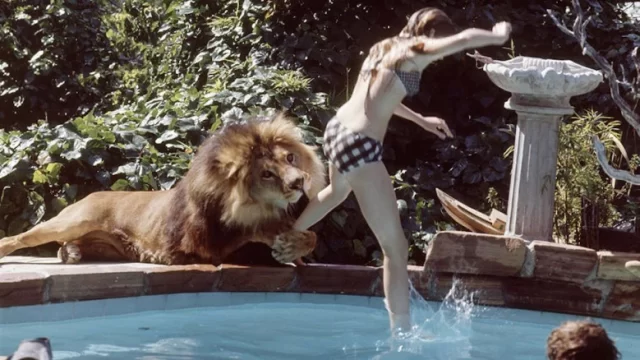A couple of decades before YouTube, 1981 audiences saw, essentially, a 90-minute-long cat video: Roar, a story of a man trying to keep a wild animal sanctuary open in the face of government hostility and, naturally, poachers. Meanwhile, his family comes to visit, clueless about the danger they’re heading into. With very little plot to get in the way, this is more a work of contemplative cinema. You’ll mainly be contemplating where humanity resides in the food chain.
It’s a fascinating spectacle, made even more fascinating because the performers were an actual family who actually lived with big cats. The Birds’ Tippi Hedren apparently traded in feathers for felines and brought her daughter Melanie Griffith with her to shoot Roar with her husband, Noel Marshall and his two sons, John and Joel. Watching them get playfully mauled by lions, tigers, and even an elephant, I couldn’t help but wonder how much footage was shot but ruined by the animal cast knocking over and destroying equipment.
I’ve been “lucky” enough to see Roar twice on the big screen, the first time as a midnight screening at a local arthouse theater. The lateness of the screening certainly did it no favors, but the experience of watching this in a crowd, especially that crowd, made it enjoyable. The second time was a secret screening, even though I’d guessed what it was about ten seconds before the lights went down thanks to a hint dropped by the programmer. I nearly walked out, but I’m glad I stuck it out, as it allowed me to focus more on the rhythm of the film without being distracted by the fate of our small human cast. Watching big cats doing cat things to small humans can be kind of hypnotic, especially in a repetitive sequence of the humans running from the cats, the cats chasing after the humans, the humans trying to find a hiding place, the cats finding the humans in their hiding places, rinse, repeat. It almost feels like a live-action Tom and Jerry cartoon, without the humans ever really getting the upper hand.
Even more fascinating is how much danger the cast and filmmakers were actually in while making this movie. Cinematographer and future Speed director Jan de Bont, got 150 stitches sewing his scalp back on, but he returned to finish the film. Melanie Griffith received 50 stitches and nearly lost an eye. The film itself was a huge bomb, unsurprisingly, but it does have some cult status and led Hedren to form The Roar Foundation to support the Shambala Preserve, the California wildlife refuge where she shot the film. I’m tempted to get the blu-ray for the making-of documentary and commentary by John Marshall. I may also have to check out the Animal Planet documentary about the making of the film, as well.

